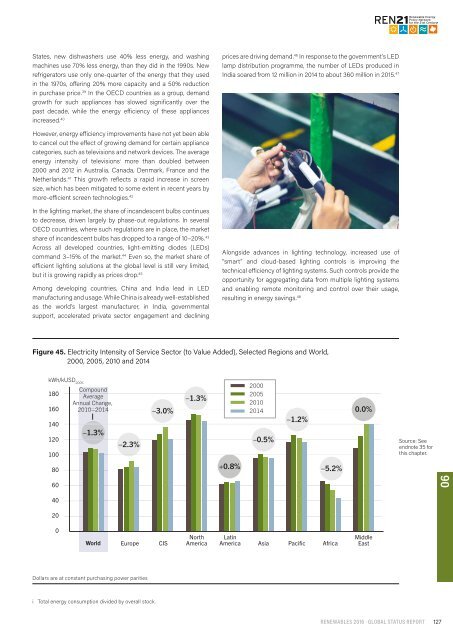2j7YOwO
2j7YOwO
2j7YOwO
You also want an ePaper? Increase the reach of your titles
YUMPU automatically turns print PDFs into web optimized ePapers that Google loves.
States, new dishwashers use 40% less energy, and washing<br />
machines use 70% less energy, than they did in the 1990s. New<br />
refrigerators use only one-quarter of the energy that they used<br />
in the 1970s, offering 20% more capacity and a 50% reduction<br />
in purchase price. 39 In the OECD countries as a group, demand<br />
growth for such appliances has slowed significantly over the<br />
past decade, while the energy efficiency of these appliances<br />
increased. 40<br />
prices are driving demand. 46 In response to the government’s LED<br />
lamp distribution programme, the number of LEDs produced in<br />
India soared from 12 million in 2014 to about 360 million in 2015. 47<br />
However, energy efficiency improvements have not yet been able<br />
to cancel out the effect of growing demand for certain appliance<br />
categories, such as televisions and network devices. The average<br />
energy intensity of televisions i more than doubled between<br />
2000 and 2012 in Australia, Canada, Denmark, France and the<br />
Netherlands. 41 This growth reflects a rapid increase in screen<br />
size, which has been mitigated to some extent in recent years by<br />
more-efficient screen technologies. 42<br />
In the lighting market, the share of incandescent bulbs continues<br />
to decrease, driven largely by phase-out regulations. In several<br />
OECD countries, where such regulations are in place, the market<br />
share of incandescent bulbs has dropped to a range of 10–20%. 43<br />
Across all developed countries, light-emitting diodes (LEDs)<br />
command 3–15% of the market. 44 Even so, the market share of<br />
efficient lighting solutions at the global level is still very limited,<br />
but it is growing rapidly as prices drop. 45<br />
Among developing countries, China and India lead in LED<br />
manufacturing and usage. While China is already well-established<br />
as the world’s largest manufacturer, in India, governmental<br />
support, accelerated private sector engagement and declining<br />
Alongside advances in lighting technology, increased use of<br />
“smart” and cloud-based lighting controls is improving the<br />
technical efficiency of lighting systems. Such controls provide the<br />
opportunity for aggregating data from multiple lighting systems<br />
and enabling remote monitoring and control over their usage,<br />
resulting in energy savings. 48<br />
Figure 45. Electricity Intensity of Service Sector (to Value Added), Selected Regions and World,<br />
2000, 2005, 2010 and 2014<br />
Figure ??. Electricity intensity of service sector (to value added), World and by Region, 2000, 2005, 2010, and 2014<br />
180<br />
160<br />
140<br />
Compound<br />
Average<br />
Annual Change,<br />
2010–2014<br />
–3.0%<br />
–1.3%<br />
2000<br />
2005<br />
2010<br />
2014<br />
–1.2%<br />
0.0%<br />
kWh/kUSD 2005<br />
–1.3%<br />
120<br />
100<br />
–2.3%<br />
–0.5%<br />
Source: See<br />
endnote 35 for<br />
this chapter.<br />
80<br />
+0.8%<br />
–5.2%<br />
60<br />
06<br />
40<br />
20<br />
0<br />
World<br />
Europe<br />
CIS<br />
North<br />
America<br />
Latin<br />
America Asia Pacific Africa<br />
Middle<br />
East<br />
Dollars are at constant purchasing power parities<br />
i Total energy consumption divided by overall stock.<br />
RENEWABLES 2016 · GLOBAL STATUS REPORT<br />
127



